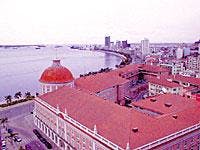West Africa
Maritime rivals choose peace over conflict
After years of conflict in the various maritime boundaries along the hydrocarbon-rich Gulf of Guinea, governments are beginning to sign pacts for peaceful collaboration.
Less than a month after Congo (Brazzaville) and Angola signed an agreement establishing the basis for joint exploration and development of a specific zone straddling their common maritime border, the Nigerian government gave hints of hastening the implementation process in the joint development zone (JDZ) between Nigeria and the islands of Sao Tomé and Príncipe.
Some 50 Bbbl of oil have been discovered in the Gulf of Guinea waterway in the South Atlantic. Until 1999, the countries along this zone - Gabon, Cameroon, Equatorial Guinea, Sao Tomé and Príncipe, Angola, the Democratic Republic of Congo, and Nigeria - saw straddling oil fields and neighboring hydrocarbon pools as sources of conflict. Nigeria and Cameroon are at the International Court in The Hague to contest rights to the Bakassi Peninsula and its offshore environs - an oil-rich borderline terrain.
Congo and Angola have pursued policies that encouraged confusion among companies interested in prospects located near the maritime boundary. Meanwhile, Equatorial Guinea laid claims to reservoirs considered by Nigeria to be within its borders.
Things began to change when Nigeria returned to democracy in 1999. At that time, the new government began calling for truce with all neighbors, but more importantly, pushing ahead for the creation of a Gulf of Guinea Commission. While there is still much paperwork to be done on this old idea, the concept of a JDZ, or outright concessions of oil fields, has taken root. Nigeria has signed a treaty with Equatorial Guinea, which involved Nigeria's recognition of Equatorial Guinea's sovereignty over the $1.5-billion ExxonMobil-operated Zafiro oil complex and associated oil fields. In return, Equatorial Guinea conceded acreage further south where France's Elf-Acquitain has rights on both sides.
The Congo/Angola agreement is a step further from the protocol agreement signed by the two parties in September 2001. The document awaits ratification by the executive and legislative institutions of both countries. The protocol agreement specifies that Angola and Congo will provide for the unitization of two prospects, Nkouimbi in the A-IMI sector of the Haute Mer permit in Congo, and 14k in the Block 14 PSA in Angola. A specific joint exploration/development zone was defined. The zone covers 696 sq km within the contested zone between the two countries to the west of appraisal D-14-6X in the Landana Field. The agreement provides for the establishment of a joint committee, responsible for the supervision of the activities within the joint exploration/development zone.
Meanwhile, the Joint Development Authority, set up to manage the overlapping maritime boundary claims between Nigeria and Sao Tomé and Príncipe, has its headquarters in Abuja, Nigeria, and a liaison office in Sao Tomé. The JDZ is the result of the ratification of a draft treaty signed by the ministers of petroleum as well as the heads of state in both countries by the respective legislatures of both countries.
Dry season in Angola
Development activities offshore Angola are shaping up with Girassol coming onstream at 200,000 b/d, soon to be followed by Dalia, (scheduled to come on stream in 1Q 2005. However, things have been flagging in the exploratory area. The last quarter has seen a spate of dry wildcats.
In April, Cabgoc, the ChevronTexaco subsidiary, abandoned wildcat Gabela 1, spudded in February, in 4,017-m water depth in deepwater Block 14. What makes the result of Gabela 1 noteworthy is the fact that the dry hole is 3.7 km west of the D-14 07 sub-commercial oil discovery made by Chevron in 1998. D-14 07 tested 275 b/d from a 23-m zone in the Upper Miocene below 1,386 m. This result comes at a time when Chevron's confidence in Block 14 is growing and where Kuito Field already is producing at 70,000 b/d.
But while ChevronTexaco's lackluster result on Gabela 1 may be surprising, TotalFinaElf's luckless Mariposa 1 is not. After all, the well is located in Block 19, in deepwater Kwanza Basin, a province that has hardly seen a successful well. TFE subsidiary Fina Oil & Gas West Africa BV abandoned Mariposa 1 in April.
Mariposa 1 was drilled in 1,231 m of water about 60 km west-southwest of the Mubafo 1 oil discovery (Conoco, Block 5, 1987) in the northern portion of the license. A second commitment well is due later this year. The company initiated a process to farm out its 30% interest in the license in July 2000.
The deepwater Kwanza Basin has been experiencing dry hole after dry hole. The result of TFE's Mariposa 1 comes after Australian independent BHP plugged and abandoned Iona 1 in Block 21 as a dry well in the same basin. Iona 1 targeted tertiary sands and was drilled in 1,600 m of water. Agip had earlier plugged and abandoned Leao 1 in Block 25 as a dry hole, and ExxonMobil plugged and abandoned Eova 1 in Block 24 after encountering thin oil-bearing zones rated as sub-commercial. The only commercially successful well in the deepwater Kwanza Basin has been ExxonMobil's Semba 1, the company's first well on the same lease, which was abandoned in April 2001 after testing a combined 3,039 b/d from two reservoirs.


